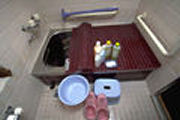![]() Japanese Bathing おふろ(お風呂)
Japanese Bathing おふろ(お風呂)
Bathing practices in Japan are quite different than in Western cultures. For example, there is a big different between “taking a shower” (シャワーをあびます、シャワーを浴びます) and “taking a bath” (おふろにはいります、お風呂に入ります). In Japan, the main purpose for “taking a shower” is to get clean BEFORE entering the bath to soak and relax. Note that the verb for “take” a shower is different than the verb for “take” a bath (お風呂に入ります literally means “to enter the bath”).

The typical Japanese bathroom consists of two or three room. First there is an entrance room where you undress and which is equipped with a sink (せんめんじょう、洗面上), and the actual bathing room is beyond that, and is usually equipped with a separate shower and a deep bath tub. The shower is used to “clean” and the bathtub is used to “soak” and relax in very hot water. The bathtub often has a self-heating element in the wall (a true おふろ、お風呂) and the water is typically used more than once by family members, and covered to keep it warm. The toilet (トイレ) is almost always located in a completely separate room or third room, and may not even be located in the same area as the other two rooms.
When bathing Japanese style, you are supposed to first completely clean your body outside in the “shower room” and typically a low, small stool is used to sit on while using a plastic wash bowl and a moveable shower nozzle. The whole room is usually part of the “shower room” (including the bathtub) so everything can get wet in the room. After washing your hair and body thoroughly, you enter the tub, which is used for soaking only. The bath water tends to be relatively hot for Western bathing standards, and is re-used by family members and covered after use to stay warm and ready for use again. Normally, another shower procedure is used to rinse off after soaking in the tub.
Modern bath tubs can be programmed to be automatically filled with water of a given temperature at a given time, or to heat up the water to a preferred temperature. Many toilets in Japan also use electronic controls for toilets and they often have heated seats, especially in colder parts of Japan.
Some words that can be used to refer in a general, overall way to bathrooms include おてあらい(お手洗い)or “washroom” (more for the sink area of the bathroom), おふろば(お風呂場)or “bathing room” (more for the bathtub area of the bathroom), せんめんじょう(洗面上)or “sink room” (more for the “sink” area of the bathroom), よくしつ(浴室)or “bathroom” (an overall term), or finally (and least polite) the トイレor “toilet” which really refers to the separate toilet room.
![]() Practice - Flashcards
Practice - Flashcards
You should be remembering to repeat Japanese as much as you can when you hear Japanese in the course and it is also imperative that you spend time outside of class studying your Japanese.
Before we get going very far, see how well you're doing on this Unit's vocabulary. The following flash card activity will help you learn your vocabulary. See if you know what each word or phrase means. Click "Begin" to hear the words. Go to a new word by clicking the "Next" in the controls at the bottom.
Click Flashcards or click Begin below.
Here is a print version of this actvity. You will still need to use the online version to hear the words.
![]() Yard Work
Yard Work
Here are a few expressions for chores that have to be done outside the home. Note the specific verbs used in each of these expressions for “cutting” the grass and “watering” the flowers. These are verbs you will use only in these contexts. Note also that やります is often used in some parts of Japan to replaceしますbut you should use it ONLY in this context.
 |
 |
| しばふを かります。(芝生を 刈ります。)
|
き/はなに みずをやります。(木/花に 水を やります。)
|
![]() Graded Assignments
Graded Assignments
Please return to the Section 3 Tasks & Assignments folder to complete the graded assignments for Section3, Part A.


